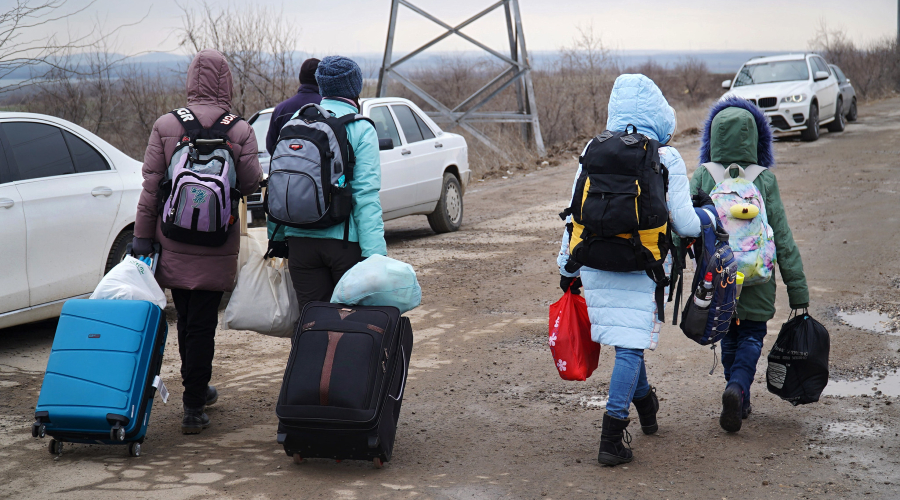Addressing the Effects of Civilian Targeting: Lessons from Syria for Ukraine

Published by The Lawfare Institute
in Cooperation With

Editor’s Note: Even if the fighting in Ukraine is resolved soon, its effects will endure for years or even generations. Reva Dhingra, a postdoctoral fellow at the Brookings Institution, examines the experience of Syrians displaced by the Russian bombing and brutal civil war there to draw lessons for the risks facing displaced Ukrainians today and how host countries might better care for them.
Daniel Byman
***
Over the course of its nearly year-long invasion of Ukraine, Russian forces have repeatedly conducted airstrikes against nonmilitary infrastructure and civilian residences in a campaign to both cripple the country’s basic services and sow terror among its inhabitants. The attacks have been remarkably consistent. On Jan. 15, a Russian missile struck an apartment building in Dnipro, killing at least 46 people; it was the deadliest attack on civilians since the Russian military bombed a public square in Chernihiv on March 3, 2022. In between, Russian attacks have hit playgrounds, hospitals, and schools across the country.
Multiple analysts have drawn comparisons between Russia’s attacks on civilians in Ukraine and its tactics in Syria. In the course of more than a decade of war, Russia has directly supported Bashar Assad’s regime in Syria in its bombardment of hospitals, bread lines, and schools—refusing to adhere to basic humanitarian law against civilian targeting. These assaults were used to brutal effect in local sieges and as part of what some observers have called a strategy of deliberate forced displacement. While civilian targeting during war has a long history, the visibility of this strategy reached new levels during the Syrian civil war as a result of media coverage and civilian documentation.
Russia’s campaign in Syria offered a road map for violence against civilians as part of its strategy in Ukraine. The war in Syria also offers insights into the potential immediate and long-term psychological and political effects that civilian targeting will have on Ukrainians both still inside the country and the nearly 8 million displaced as refugees. As research on the Syrian conflict and other wars demonstrates, civilian exposure to violence has concrete implications both for individuals’ mental health and for their medium- and long-term political attitudes and behavior. Understanding these effects is crucial for supporting the Ukrainian population in the short and long terms—and requires learning from how efforts have fallen short, and continue to do so, in other conflict settings, such as Syria.
Psychological Effects
Researchers have demonstrated that direct exposure to violence during the Syrian civil war deeply affected individuals’ mental health and, particularly in the case of children, cognitive outcomes that could have long-term consequences for society.
Among refugees, research from the early years of the conflict widely indicated high rates of post-traumatic stress disorder (PTSD), anxiety, and depression—particularly for individuals who had direct experiences of violence. Refugees’ trauma from direct exposure to violence is also often compounded by social exclusion and economic insecurity experienced in host countries. Many Syrian refugees initially faced and continue to face significant barriers to accessing the labor market, and, as of 2021, poverty rates among Syrian refugees have exceeded 70 percent. M.K. Hamza, chair of the Syrian American Medical Society (SAMS), coined the term “human devastation syndrome” to describe the mental health effects of the conflict for Syrian refugees, who, in addition to experiencing violence and the loss of their homes, have experienced further devastation due to economic and social deprivation while displaced. Financial circumstances, an inability to speak the host nation’s language, and poor quality of services present even greater barriers to accessing care for many displaced Syrians.
Direct exposure to violence may also have long-lasting cognitive mental health implications for a generation of Ukrainian children unless these effects are addressed early. A 2020 survey of children in Damascus found that more than 50 percent of students suffered from PTSD. As is the case for adults, the effects of conflict exposure on Syrian children have been exacerbated by conditions in displacement. For example, a 2019 study found that high poverty rates among Syrian children in Lebanon were associated with poorer cognitive outcomes. Along with low school attendance rates (2.4 million Syrian children were out of school in 2022), the cognitive and mental health effects of violence and displacement have created a “lost generation” of Syrians, and the international community’s early and current responses have been insufficient.
Welcoming labor and social policies for Ukrainian refugees and an early focus on the mental health effects of conflict paint a more optimistic picture for Ukrainians compared to Syrians. Yet a recent study in Poland found that at least one in 10 Ukrainian refugees surveyed were experiencing significant mental health issues. Many cited barriers to care similar to those experienced by Syrian refugees, such as language, financial means, and cultural stigma.
Political Effects
The evidence further indicates that the deep psychological effects of violence against civilians will have both short- and long-term implications for Ukrainian citizens’ political behavior. Researchers have found that Syrian refugees with direct experiences of indiscriminate government airstrikes using barrel bombs were more likely to say that no side in the conflict represented them, even if they were also more opposed to the Assad regime than other refugees who had not experienced barrel bombing. While the war in Ukraine is not a civil war like the one in Syria, Russia’s efforts to inflict a civilian toll reflect a similar desire to decrease the high levels of political support among Ukrainians for continuing the war. Work on postconflict settings also demonstrates the lasting power of civilians’ experiences of violence in shaping their political attitudes. Recent research on voting turnout in postconflict Bosnia and Herzegovina shows that violence against civilians has decreased individuals’ trust in state institutions and led them to disengage from politics, even more than two decades after the conflict’s end.
With analysts discussing the importance of centering refugees and internally displaced persons in any reconstruction plan for Ukraine, it is also crucial to consider how the psychological effects of violence against civilians will factor into the return of refugees and internally displaced persons. Some observers have predicted that the war in Ukraine will develop into a “frozen conflict,” in which frontlines will solidify without a peace settlement or victory for either Ukrainian or Russian forces. Recent research surveying Syrian refugees in Lebanon indicates that those with direct exposure to violence are actually more likely to express an intent to return to Syria because their attachment to their homeland led them to remain longer than many other refugees—leaving only following the direct experience of violence. But should a frozen conflict develop, Russia’s policy of targeting civilians will likely weigh on refugees’ decisions about whether or not to return; many may fear that no part of Ukraine will be truly secure from Russian attacks while the conflict persists.
Lessons for Political and Humanitarian Response
The humanitarian response to the Ukraine conflict is still developing and well-resourced enough to avoid many of the mistakes that were made in supporting Syrians, who fall lower on global priority lists each year and for whom the widespread trauma of violence and exclusion will have social and political ramifications for years to come. While policymakers are investing resources in Ukraine, they would do well to recall the survivors of other conflicts that have disappeared from the headlines. Yet these conflicts do offer lessons for concrete policy interventions for mitigating the negative psychological effects of civilian exposure to violence in Ukraine early on.
For civilians displaced or close to the frontlines inside Ukraine, emergency mental health programs will need to be expanded and outreach will be crucial. This means increasing both the availability of clinical mental health services as well as “psychosocial” support that integrates emotional and social well-being into schooling or other programs. Organizations such as SAMS have provided telemedicine for individuals in hard-to-reach conflict areas within northern Syria; similar remote support could be helpful for Ukrainians in conflict-affected areas.
For refugees, experts have recommended screenings on arrival and group-based interventions, which will be particularly necessary for survivors of violence. Training refugee volunteers to serve as interpreters for mental health providers and ensuring that refugees who were mental health providers have opportunities to provide care is also key. Measures that support integration, such as work permit programs, will also be crucial and, given the strong linkage between mental health and economic inclusion, should be extended as long as necessary.
An understanding of the political impacts of civilian targeting should also inform future approaches to conflict negotiation and resolution in Ukraine, particularly in contested areas. A wealth of evidence demonstrates that experiencing violence can increase community solidarity and altruism; these strengthened bonds of community should be leveraged to rebuild Ukrainian society in hard-hit areas. Programs that focus on building trust in institutions will also be crucial in any postwar period.
Russia learned from its campaign in Syria that targeting civilians can have devastating effects on the population. It is now applying those lessons to Ukraine in an effort to cow Ukrainians into accepting territorial concessions. But Syria and other similar conflicts also have lessons for how the international community can respond and help support civilians carrying the traumas of Russia’s indiscriminate attacks. Relief efforts should be learning from the Syrian experience as well.





